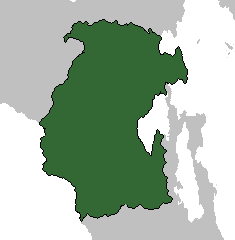Anáhuac: Difference between revisions
(Created page with "{{Infobox country |conventional_long_name = Gran Rugido |native_name = República Federal del Gran Rugido |image_flag = 100px|frameless |i...") |
mNo edit summary |
||
| Line 3: | Line 3: | ||
|native_name = República Federal del Gran Rugido | |native_name = República Federal del Gran Rugido | ||
|image_flag = | |image_flag = | ||
[[File:Flag GR. | [[File:Flag GR New.jpg|100px|frameless]] | ||
|image_coat = | |image_coat = | ||
[[File: | [[File:GR New CoA.png|100px|frameless]] | ||
|national_motto = Semper Ascendens | |national_motto = Semper Ascendens | ||
|englishmotto = Always Ascending | |englishmotto = Always Ascending | ||
Revision as of 19:36, 5 April 2021
Gran Rugido República Federal del Gran Rugido | |
|---|---|
| Motto: Semper Ascendens Always Ascending | |
| Anthem: "El Rugido de la Nación" | |
 | |
| Capital | Laurua |
| Largest city | Santa Elisa |
| Official languages | None at federal level |
| Recognized languages | Spanish and 12 Amerindian languages. |
| Recognised national languages | Spanish |
| Ethnic groups | Sapinish, Lauruan, Mayaʼtʼàan, Dizhsa, En Ngixo & Tarascan |
| Religion | 88.9% Christianity
—77.7% Roman Catholic —11.2% Protestantism 8.1% Irreligious 0.2% Other religions 2.5% Unaffiliated (believer) |
| Demonym(s) | Rugidoan, Gran Rugidoan |
| Government | Federal presidential constitutional republic |
| Matías Larrazábal Torres | |
| Elisa Sánchez Cordero | |
• President of the Senate | Odilo Beltrones Leyva |
| Legislature | Congress |
| Senate | |
| Chamber of Deputies | |
| Independence from: The Veritian Empire | |
• Declaration of Independence | April 2, 1808 |
• Consumated | January 6, 1810 |
• First constitution | December 12, 1811 |
• Second Constitution | May 5, 1860 |
• Rugidoan Spring | August 12, 1911 |
• Santa Elisa Accords | September 19, 1970 |
| Area | |
• Total | 1,122,279 km2 (433,314 sq mi) |
| Population | |
• 2020 census | 103,002,766 |
• Density | 91.78/km2 (237.7/sq mi) |
| GDP (PPP) | 2020 estimate |
• Total | 1.275 trillion |
• Per capita | 5,066 |
| GDP (nominal) | 2020 estimate |
• Total | $443 billion |
• Per capita | 2,149 |
| Gini (2016) | 45.1 medium |
| HDI (2019) | 0.770 high |
| Currency | Rugidoan Peso ([https://en.wikipedia.org/wiki/ISO_4217 ISO 4217]) |
| Time zone | UTC+5 UTC +6 |
| Date format | dd-mm-yyyy |
| Driving side | right |
| Calling code | +52 |
| Internet TLD | .gr |
Gran Rugido, officially the Federal Republic of Gran Rugido is a country in the center portion of Olivacia, Anteria. It is bordered to the north by Savane; to the northwest by J a d e; to the south by Marlenka, to the east by Dallsard and Lake Girón and to the west with the Sunadic Bay. Its capital is Laurua, and its most populated city is Santa Elisa. Politically it is a representative, democratic, federal, and secular republic, made up of 9 states (8 states and the federal capital).
Gran Rugido has been inhabited by various indigenous peoples since at least 12,000 BCE, including the Sapinish, the Dizhsans and the Tarascanians. The Veritians landed first in Laurua in 1670 and by the end of the 16th century colonized parts of the region, establishing the New Kingdom of Veritia, with Santa Arca as its capital. Independence from the Veritian Empire was achieved in 1810, with what is now Gran Rugido emerging as the First Republic of Gran Rugido. The new nation experimented with federalism as the Federation of Gran Rugido (1869), before the Federal Republic of Gran Rugido was finally declared in 1880. The Rugidoan Spring of 1911-1914 led to a new and the actual constitution. Beginning in the 1960s, the country suffered from an asymmetric low-intensity armed conflict and political violence, which escalated in 1968 into a full-scale civil war that lasted until 1970. Since 1982, there has been significant improvement in security, stability, and rule of law, as well as unprecedented economic growth and development.
History
TBA
Geography
TBA
Climate
TBA
Flora and Fauna
TBA
Government and Politics
Government
TBA
Politics
TBA
Foreign relations
TBA
Military
TBA
Law Enforcement
TBA
Political Divisions
TBA
Economy
TBA
Communications
TBA
Energy
TBA
Science and technology
TBA
Tourism
TBA
Transportation
TBA
Water supply and sanitation
TBA
Demographics
Ethnicity and race
TBA
Languages
TBA
Urban areas
TBA
Religion
TBA
Health
TBA
Education
TBA
Culture
Painting
TBA
Sculpture
TBA
Architecture
TBA
Photography
TBA
Literature
TBA
Cinema
TBA
Media
TBA
Cuisine
TBA
Music
TBA
Sports
TBA

